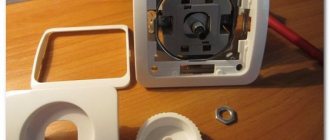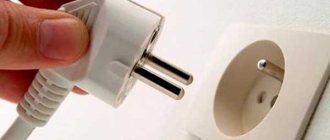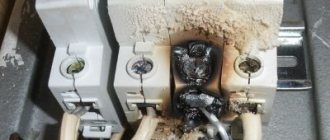Crackling noise when plugged in
This phenomenon is observed quite often - for example, if you leave home for several days and unplug electrical appliances from the outlets. Upon returning, everything turns back on and then a noticeable flash is visible in some sockets and a loud crack is heard.
Despite the fact that this all looks quite threatening and causes many to reflexively pull their hands away from the sockets, there is nothing in this phenomenon that indicates a malfunction. It’s just that when the contacts of the plug approach the contacts of the socket, an electric arc jumps between them an instant before contact. This is the nature of electric current and the higher the voltage at the contacts, the greater the distance such an arc can stretch.
In industrial conditions, special arc-extinguishing chambers are made near the contacts of starting devices, and in particularly powerful devices, devices are even used to extinguish the arc with compressed air or another method.
What’s interesting is that reflexively withdrawing your hand from such an outlet is completely meaningless. And not because this phenomenon is not dangerous, but because of deception of vision and hearing due to the imperfection of these sense organs. The fact is that the microlightning that occurs when contacts touch lasts a hundredth, if not a thousandth, of a second.
Given that the human eye perceives everything at a speed of 24 frames per second, it only sees the original image captured on the retina and gradually fades away. It’s the same with sound - an audible crack is thunder in miniature - first the primary disturbances of the air reach the ear, and then the consequences of displacements of its molecules.
READ MORE: Electric concrete mixer, recommendations for choosing
What can be done
It would seem that the issue has been resolved and now you can simply not be afraid of this phenomenon, if not for one “but” - not every socket sparks... This is even more surprising if all the installed sockets are the same, which means that this behavior cannot be explained by differences in design.
The reason is simple - plugs from switched-off devices are inserted into some sockets, and plugs from switched-on devices are inserted into others, on the contrary. Take a computer for example - usually all its peripherals are connected to one surge protector with 5-6 outlets. This is the system unit itself, a monitor (or even two), speakers, a printer, a router - maybe something else is connected.
When the computer is turned off, in fact, it is not completely de-energized - all its components are in standby mode, so if you unplug the surge protector from the socket, it will “remember” its last state. Accordingly, when the plug is inserted into the socket again, all devices will simultaneously “fucking” the electric current, which will cause a discharge in the socket.
This will not happen if, before leaving, you turn off the power to each device separately - manually turn off the monitors, turn the switch on the power supply of the system unit, flip the toggle switch on the speakers and the printer. Then, when the plug is plugged into the socket, the circuit will not close and there will be no discharge.
Theoretically, when even microlightning occurs, the surface of the contacts burns and may become unusable over time - the resulting soot will cover everything with a film with high resistance, this place will begin to heat up and the socket may begin to melt.
In practice, the discharge hits the tip of the plug and the very beginning of the socket contact - when the plug is fully inserted, the working surface of the contacts is completely different. Moreover, if the plug is not taken out of the socket often, then the contact is very far from being damaged.
As a result, when the socket sparks when you turn on the plug, you need to realize that everything has already happened and simply insert the plug further.
READ MORE: DRL lamps: design and operating principle of a gas-discharge light bulb
Why does it spark when I plug my laptop charger into sockets?
Let's look at a simpler example. Let's take a table lamp. If its switch is turned to the “on” position, then, in fact, the entire chain from one end of its plug to the other is a continuous conductor, without breaks. Now we will insert the plug into the socket. For simplicity, we assume that the contacts of the two pins of the plug with the sockets of the socket do not occur simultaneously, but with some gap in time. Even if this happens at the same time, the result will be the same, it’s just that it’s more convenient and clearer to look at it the way I suggested. What happens? When one pin of the plug touches the socket (comes into electrical contact with it), the potential of this socket will almost instantly (at a speed of about 300,000 km/s) appear on the other pin of the plug. And this pin is approaching its socket.
In Russia, we have a sinusoidal voltage in the electrical network with an amplitude of 311 V (the average value for half a cycle is 220 V), with a frequency of 50 Hz. The period is 0.02 seconds (20 milliseconds).
Let's say that at the initial moment of time the potential difference was equal to zero. During the first 5 milliseconds, the potential difference increases sinusoidally to 311 V, over the next 5 milliseconds it again drops to zero, over the next 5 milliseconds it again increases to 311 V (but with a sign change), over the next 5 milliseconds it drops to zero, and this is repeated many times.
This means that for a breakdown to occur from 311 V, the distance between the pin and the socket must be 0.15 mm.
Therefore, as soon as the pin approaches the socket at such a distance, a spark will jump between it and the socket (naturally, when the distance becomes less than 0.15 mm, the spark will jump even at a smaller potential difference).
If we insert the plug into the socket with the switch in the “off” position, then none of this will happen. More precisely, this will all happen, but not in the socket, but in the switch, at the moment the lamp “turns on.”
And this ALWAYS happens the moment any electricity consumer turns ON.
Your charger is probably designed in such a way that it is always on, i.e. Like the situation described above with a table lamp, the entire chain from one pin of the charger plug to the other is a continuous conductor without electrical breaks.
In exactly the same way, sparks flash in the switch of an ordinary light bulb or chandelier. This can be noticed when the light bulb is turned on in the dark, i.e. when the switch is in the dark.
Socket sparks due to overload
A socket, like, in principle, any other household appliance, has certain characteristics and parameters. Each product is marked accordingly. For example, a 16 A and 250 Volt outlet can withstand a load of 3.5 kW.
- 6 Amps – 1.3 kW
- 10 Amps – 2.2 kW
- 32 Ampere – 7 kW
Exceeding the maximum permissible loads will lead to overheating of the socket contacts. As a result, they burn and resistance increases. Based on this, we can conclude that a large number of extension cords and overly powerful devices cannot be plugged into one outlet.
Eliminating the causes of sparks from the outlet
After all the above-described causes of sparking, let’s move on to the method of eliminating them. If the plug and socket do not match, it is necessary to bring them to a single standard. Replace all existing sockets with a modern version, manufactured according to European standards. If you don’t want to part with an electrical appliance from the distant past, then simply replace the old plug with a new one and the problem of the plug not matching the socket will be eliminated in an easy and affordable way.
There are several ways to fix an outlet reboot. The first is the replacement of electrical installation equipment with more powerful ones. If you have 10.0 A sockets installed, then replace them with 16.0 A. This will significantly increase the power of the socket and will not lead to overheating of the equipment and causing a spark. And the second way is to install additional sockets in the room. The second solution to the problem is much more reliable than the first, since you do not have to use carriers and tees. If you do not have the ability to install an additional outlet. Use a double socket, which is mounted on one seat.
There is no possibility of installing an additional socket; use a double socket, which is mounted on one seat
If there is a problem with the clamps loosening, work on tightening the contacts. At the same time, do not forget about the importance of turning off the power supply. It is recommended to tighten copper wiring once every 10 years. But aluminum - at least once every two years. Therefore, it is more advisable to replace the wiring with copper, which is of higher quality and more durable.
And one more piece of advice. Do not try to buy the cheapest materials, such savings can have serious consequences. Such as the loss of residential property due to fire, which happens very often in our country. To distinguish a counterfeit from an original, pay attention to the price of the product. The original product will cost many times more, request product certificates. Counterfeit goods are made from low-quality materials. Therefore, you can visually see the differences, for example in the body. The quality of the plastic will be different, incomplete packaging or lack of packaging on the product.
If the socket cracks during operation
If a cracking sound is heard when the plug is in the socket, then this is already a sign of poor contact in some part of the electrical circuit. Often, over time, the surface of the plug or the socket itself heats up, or even all at once.
In fact, a working socket makes noise for the same reason as when inserting a plug - the contacts do not touch closely, and in some places they do not reach each other. The consequences are standard: their surface oxidizes, resistance to electric current increases and the metals begin to heat up.
In the same way, a socket cracks if the bolted connections are loosened - the wire inside the contact begins to move and protrusions form, between which sparks appear. The socket begins to make noise, and if the contact is very bad, it can heat up and melt.
Also, the cause of sparking may be a mismatch in the diameter of the pins of the plug and the contacts of the socket; a typical example is when an old Soviet plug is inserted into a modern Euro socket.
Euro plug on the left, Soviet plug with smaller diameter pins on the right
How to avoid problems: crackling in the socket
Above we described the main reasons why a socket may make noise and spark when the plug is turned on, and methods for repairing accessories with your own hands. Now we should talk about how to prevent problems, or in other words, about prevention.
Preventive measures are as follows:
- At least once a year it is necessary to inspect the wiring.
- You need to visually inspect all electrical appliances in the house.
- The plug must be inserted and removed from the socket smoothly; this can only be done when the power supply to the device is turned off.
To avoid serious problems and consequences, it is necessary to inspect the wiring at least once a year.
The course of action using TV as an example is as follows. Connect to the mains, press on. and vice versa - turn off the TV. We take out the plug from the electrical outlet. Install a circuit breaker on the outlet line, which will prevent overvoltage in the network and save not only the outlet.
Low quality
As I wrote earlier in my article “What You Shouldn’t Save on When Repairing,” electricians do not tolerate purchasing low-quality products. If you are not yet familiar with this material, you can read it at this link. You can try to save your money on laminate, paint or drywall, but in no case on electrical fittings and wiring.
READ MORE: What to do if, when you turn on the stove, the light blinks and the TV turns off?
Such savings will not only lead to possible breakdowns of other household appliances, but will also create a fire hazard in the home. A high-quality product will easily withstand the load indicated on it. Cheap options from unknown manufacturers can even be burned by a vacuum cleaner. It is best to purchase goods from trusted suppliers. I would recommend checking out the range and prices on Yandex Market.
Why is the socket buzzing: consequences
If you do not detect in a timely manner that the socket has sparked on its own, then sad consequences may ultimately occur.
Namely:
- Initially, the plastic body will begin to melt;
- Next, the electrical contact will begin to burn;
- Then the wiring will ignite, which will lead to a fire.
In addition, no one can rule out electric shock and short circuit. If the sockets are connected using a cable and it is clear that one of the devices heats up when the plug is removed or plugged in, this may mean that the installation was carried out incorrectly (for example, the cross-section of the electrical wires was selected to be small or the cable was not tightened properly). Adjacent devices should not be properly connected to each other; it is necessary to make a branch of electrical wires to each electrical point.
Device structure
The device is mounted in a rectangular plastic case, consisting of a 2-section base and covers. Section 1 is intended for laying spring clamps with wires for connecting to the battery and power cord. This compartment is accessed by lifting the lid.
In the second of the sections-compartments 2 there is a step-down transformer and a printed circuit board with circuit elements located on it.
Rice. 1. Appearance of the Iskra device.
On the front panel there are:
- button (3) “6V/12V”, to set the operating mode;
- indicator (4) “NETWORK”;
- indicator (5) “CHARGE”;
- button (6) “CONTROL”.
Safety requirements.
- disassemble the device while it is turned on;
- carry out work with the top cover open and the device connected to the network;
- cover the natural cooling openings of the device with any objects.











